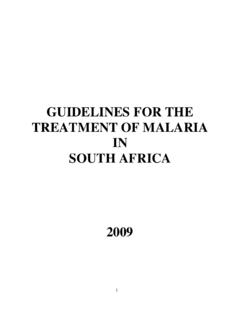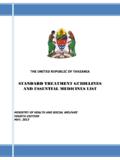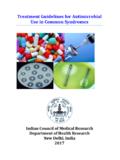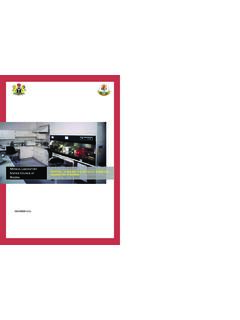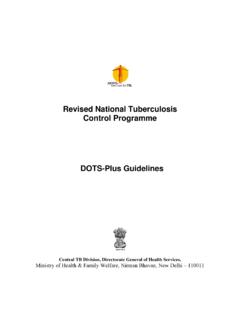Transcription of Session 10. Standard Treatment Guidelines - WHO
1 Drug and Therapeutics Committee Training Course Session 10. Standard Treatment Guidelines Participants Guide Drug and Therapeutics Committee Training Course Participants Guide iiThis document was made possible through support provided by the Agency for International Development, under the terms of cooperative agreement number HRN-A-00-00-00016-00. The opinions expressed herein are those of the author(s) and do not necessarily reflect the views of the Agency for International Development. About RPM Plus RPM Plus works in more than 20 developing and transitional countries to provide technical assistance to strengthen pharmaceutical and health commodity management systems. The program offers technical guidance and assists in strategy development and program implementation both in improving the availability of health commodities pharmaceuticals, vaccines, supplies, and basic medical equipment of assured quality for maternal and child health, HIV/AIDS, infectious diseases, and family planning, and in promoting the appropriate use of health commodities in the public and private sectors.
2 Recommended Citation The materials may be freely abstracted, quoted and translated in part or in whole by non-profit or educational organizations (for reference or teaching only) provided the original source is acknowledged. They should not be sold nor used for any other commercial purpose. Management Sciences for Health and World Health Organization. 2007. Drug and Therapeutics Committee Training Course. Submitted to the Agency for International Development by the Rational Pharmaceutical Management Plus Program. Arlington, VA: Management Sciences for Health. Rational Pharmaceutical Management Plus Center for Pharmaceutical Management Management Sciences for Health 4301 North Fairfax Drive Arlington, VA 22203 USA Phone: Fax: E-mail: Web: Developed in Collaboration with the World Health Organization Geneva.
3 Switzerland iiiABBREVIATIONS AND ACRONYMS ARI acute respiratory infection DTC Drug and Therapeutics Committee DUE drug use evaluation g gram INRUD International Network for Rational Use of Drugs IV intravenous STG Standard Treatment guideline TOT training of trainers UNICEF United Nations Children s Fund VA visual aid WHO World Health Organization Drug and Therapeutics Committee Training Course Participants Guide iv vCONTENTS Session 10.
4 Standard Treatment Guidelines ..1 Acknowledgment .. 1 Purpose and Content .. 1 Objectives .. 1 Preparation and Materials .. 1 Key Definition .. 2 Introduction .. 2 The Need: A Solution to Therapeutic Anarchy .. 2 Advantages .. 3 Disadvantages .. 5 Establishing STGs .. 5 Key Features of a Successful STG Manual .. 7 Implementing the Guideline .. 9 Activity 1. Developing a Guideline for Use during the Field Trip .. 10 Activity 2. A Case Study: A Second Edition? Standard Treatments in Pagalia .. 11 Summary .. 12 Annex 1. Case Study for Activity 2 .. 13 One Morning, Mid-1998 .. 13 Health Status and Health Care in Pagalia .. 13 Publication of the Standard Treatment .. 14 Health Center Treatment Patterns 1997 .. 14 A Second Edition? .. 15 Annex 2. Publications Relevant to the Development of STGs .. 16 Drug and Therapeutics Committee Training Course Participants Guide vi 1 Session 10.
5 Standard Treatment Guidelines Acknowledgment This Session is based on the World Health Organization and the International Network for Rational Use of Drugs. Promoting Rational Drug Use Standard Treatments (PowerPoint and Study Guides). Purpose and Content Experience has shown that even when pharmaceutical supply is based on an approved formulary or essential medicines list, ample opportunity exists for ineffective, unsafe, or wasteful prescribing. Standard Treatment Guidelines (STGs) list the preferred pharmaceutical and nonpharmaceutical treatments for common health problems experienced by people in a specific health system. As such, they represent one approach to promoting therapeutic effective and economically efficient prescribing. When implemented effectively, an STG offers advantages to patients ( , it provides more consistency and Treatment efficacy), providers ( , it gives an expert consensus, quality of care Standard , and basis for monitoring), supply managers ( , it makes demand more predictable and allows for prepackaging), and health policy makers ( , it provides focus for therapeutic integration of special programs and promotes efficient use of funds).
6 Effective implementation, however, is perhaps the greatest challenge in introducing STGs. Objectives After attending this Session , participants will be able to Understand the importance of an STG in promoting rational use of medicines Describe the implementation of a guideline in a hospital or clinic Develop an STG for a disease or medical condition Preparation and Materials Read the following Participants Guide Management Sciences for Health and World Health Organization. 1997. Managing Drug Supply. 2nd ed. West Hartford, CT: Kumarian Press. (Chapter 11, Treatment Guidelines and Formulary Manuals ) Drug and Therapeutics Committee Training Course Participants Guide 2 Key Definition Standard Treatment guideline A systematically developed statement designed to assist practitioners and patients in making decisions about appropriate health care for specific clinical circumstances Introduction The Drug and Therapeutics Committee (DTC) is responsible for numerous important pharmaceutical management functions.
7 The committee is responsible for evaluating new medicines for the formulary, identifying and correcting medicine use problems, assessing and controlling adverse drug reactions among other functions. Session 10 concentrates on an important strategy for improving medicine use in the health care system STGs. Guidelines are a valuable resource in the management of pharmaceutical therapy because Treatment of diseases may have many different approaches. Many practitioners will not remember the best method of Treatment . Applying the most effective Treatment benefits both the patient and the health care system. Formulary management will have only limited impact if medicines are used incorrectly. The development and implementation of STGs is a necessary task in a health care system where numerous treatments may be available.
8 Physicians and nonphysician providers will use their own knowledge base, training, and preconceived ideas on the Treatment rationale for each patient. Frequently, this approach is effective and reasonable and results in optimal care. Just as frequently, however, it may result in less than optimal care and in fact may result in dangerous medical care, leading to poor outcomes for the patient. The use of STGs is a time-honored system that works well and improves patient outcomes. The Need: A Solution to Therapeutic Anarchy STGs have existed for as long as the art of healing has existed. Traditional healers developed their Standard sets of cures and passed them from generation to generation. In modern medicine, however, the concept arose that more than one Treatment modality may available for many medical conditions.
9 This concept leads to confusion and, in many cases, incorrect Treatment . Doctors, nurses, pharmacists, community health workers, and other health care providers learn about all of the treatments that could be used, instead of focusing on the best Treatment that should be used. Casual observation, as well as more systematic study of prescribing practices, frequently reveals a pattern of tremendous diversity among prescribers in the Treatment of even the most common conditions. Polypharmacy is one problem; for example, three, four, five, six, and sometimes more medicines may be prescribed for acute viral gastroenteritis, for which only Session 10. Standard Treatment Guidelines 3oral rehydration therapy is effective in reducing morbidity and mortality. Other common problems are making incorrect medicine choices, overdosing, underdosing, and choosing a more expensive medicine when less expensive ones would be equally or more effective.
10 STGs also known as Standard Treatment schedules, Standard Treatment protocols, therapeutic Guidelines , and so forth list the preferred pharmaceutical and nonpharmaceutical treatments for common health problems experienced by people in a specific health system. Each pharmaceutical Treatment should include for each health problem the name, dosage form, strength, average dose (pediatric and adult), number of doses per day, and number of days of Treatment . Other information on diagnosis and advice to the patient may also be included. STGs should consider both pharmaceutical and nonpharmaceutical treatments. Reassurance, for example, might be the proper Standard Treatment for a child who is shorter than other children of his or her age, but who shows a normal growth curve, shows no signs of malnutrition or chronic disease, and has shorter than average parents.











